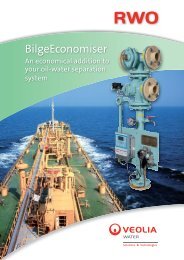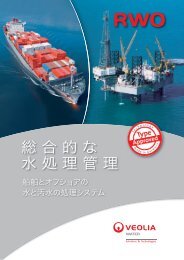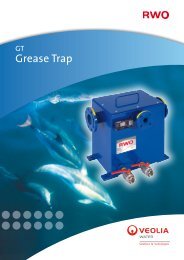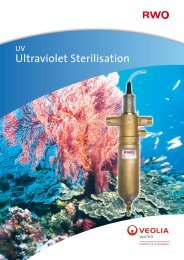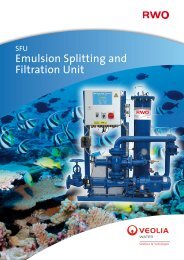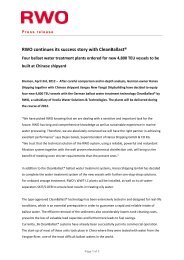the IHS Ballast Water Guide - RWO Marine Water Technology
the IHS Ballast Water Guide - RWO Marine Water Technology
the IHS Ballast Water Guide - RWO Marine Water Technology
Create successful ePaper yourself
Turn your PDF publications into a flip-book with our unique Google optimized e-Paper software.
<strong>IHS</strong> Fairplay Solutions <strong>Guide</strong> to <strong>Ballast</strong> <strong>Water</strong> Treatment Systems Sponsored by<br />
How systems work<br />
The technology used to treat ballast<br />
water has generally been derived from<br />
o<strong>the</strong>r industrial applications, in which<br />
forms of solid-liquid separation and<br />
disinfection processes were applied.<br />
The separation process concerns <strong>the</strong><br />
removal of solid suspended material from <strong>the</strong><br />
ballast water by sedimentation or straining<br />
by means of a filter. This produces a waste<br />
stream that comprises backwash water from<br />
<strong>the</strong> filtering or a hydrocyclone operation. The<br />
waste stream is discharged during ballasting.<br />
Disinfection may be achieved in a number<br />
of ways. Chemical treatment uses oxidising<br />
biocides that interfere with <strong>the</strong> microorganism’s<br />
organic structure or non-oxidising<br />
biocides that interact with reproductive<br />
or metabolic functions. Physico-chemical<br />
treatment systems use UV light, heat or<br />
cavitation. Deoxygenation is ano<strong>the</strong>r method,<br />
in which <strong>the</strong> organism is asphyxiated.<br />
Solid-liquid separation<br />
The filtration process uses discs or fixed<br />
screens with automatic backwashing and is<br />
generally effective for larger particles and<br />
organisms. The low membrane permeability<br />
means that surface filtration is not practical,<br />
so backwashing is required to maintain flow<br />
because of <strong>the</strong> pressure drop.<br />
As a means of removing larger particles,<br />
hydrocyclones are a good alternative. These<br />
separate <strong>the</strong> particles through high-velocity<br />
centrifugal rotation of <strong>the</strong> water.<br />
So, <strong>the</strong>re are three fundamental ballast<br />
water treatment technologies, which are<br />
generally combined within one system. These<br />
are mechanical, which consists of filtration<br />
or cyclonic separation; physical disinfection,<br />
comprising ultrasound, ultraviolet (UV)<br />
radiation, heat, cavitation, deoxygenation,<br />
and coagulation; and chemical treatment and<br />
biocides, comprising electro-chlorination,<br />
ozonation, chlorination, chlorine dioxide and<br />
advanced oxidation.<br />
Most systems use a two-stage approach<br />
involving mechanical separation at <strong>the</strong> first<br />
stage, followed by a second-stage physical/<br />
chemical treatment, at which some systems<br />
use a combination of two or more treatments.<br />
Operational implications, extended<br />
ballasting time as a result of pressure drops,<br />
consumables needed and energy requirements<br />
all need to be assessed. Solutions compares <strong>the</strong><br />
various technologies, each of which has its<br />
Both filtration and cyclonic separation can<br />
be improved by pre-treatment in <strong>the</strong> form of<br />
coagulation, but this needs extra tank space<br />
and an ancillary powder to generate <strong>the</strong> flocs.<br />
Oxidising biocides<br />
When diluted in water, chlorine destroys cell<br />
walls of organisms, while electro-chlorination<br />
creates an electrolytic reaction using a direct<br />
current in <strong>the</strong> water. Both methods are wellestablished<br />
municipally and industrially, but<br />
are virtually ineffective against cysts unless a<br />
10 © <strong>IHS</strong> Global Limited 2012<br />
010_011_corrected BW1204.indd 10 01/08/2012 15:27:37



